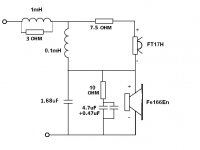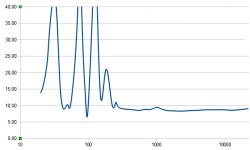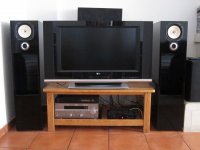After much thought, I could not resist ... I just bought the drivers for these project. Now I will need your help, since I am a complete noob.
What components should I buy now for the crossover?
According to Leonidas: 1 - 2.2uf capacitor + 1 - 2.2ohm Resistor
According to Dzius: 1 1.8uf capacitor1+ 1mH inductor +1 0,1 mH inductor + 1 2ohm resistor.
Could you give some tips?
What components should I buy now for the crossover?
According to Leonidas: 1 - 2.2uf capacitor + 1 - 2.2ohm Resistor
According to Dzius: 1 1.8uf capacitor1+ 1mH inductor +1 0,1 mH inductor + 1 2ohm resistor.
Could you give some tips?
My crossover is at http://www.diyaudio.com/forums/full...-concerti-clone-lots-pics-10.html#post3114721
I tried many other options but this one is best for me. Rigth now I use even more bass boost using 3ohm resistor paralell to 1mH coil. But frankly speaking first built it in MDF or even better in plywood before thinking about cross over. It take time every separate element glued need time for glue hardening and "setlle down". I've got a lot of experience with wood and recomend 4 hour time for glue hardening before glueing the next element over previous one. So it takes a lot of time. Additionally you need carpenter clamps to fix elements at position and proper glueing. Greater number of clamps will speed up work . All in all it's not an easy project. From this point of view FH3 is much better. But you have bought drivers so good luck !!!
I tried many other options but this one is best for me. Rigth now I use even more bass boost using 3ohm resistor paralell to 1mH coil. But frankly speaking first built it in MDF or even better in plywood before thinking about cross over. It take time every separate element glued need time for glue hardening and "setlle down". I've got a lot of experience with wood and recomend 4 hour time for glue hardening before glueing the next element over previous one. So it takes a lot of time. Additionally you need carpenter clamps to fix elements at position and proper glueing. Greater number of clamps will speed up work . All in all it's not an easy project. From this point of view FH3 is much better. But you have bought drivers so good luck !!!
I have built L'SIT amp which uses load line mechanizm to lower distortion. Concerti have appeard to play very nice with it but in a tiny bit supernatural way.
So decided to make map live easier and improve crossover by using zobel network and turn speakers into more or less constant impedance. After several attempts and listenig test final version is as follow:

Rigth now impedance plot is more leveled:

So decided to make map live easier and improve crossover by using zobel network and turn speakers into more or less constant impedance. After several attempts and listenig test final version is as follow:

Rigth now impedance plot is more leveled:

Probably not on the first, and YMMV on the latter (let nobody say I use this forum to promote my own designs) since it depends on the rest of your system, inc. the room, and personal preference. What can be said entirely objectively is that
a/ Victor is larger
b/ It's impedance matched down to a much lower frequency due to that extra size, and the fact that it's intended to be boundary loaded.
c/ More generally, the behaviour of the two boxes, in-room power-responses through the LF region etc. are significantly different.
a/ Victor is larger
b/ It's impedance matched down to a much lower frequency due to that extra size, and the fact that it's intended to be boundary loaded.
c/ More generally, the behaviour of the two boxes, in-room power-responses through the LF region etc. are significantly different.
I have swapped Fostex FE166En for Hungarian Sonido SFR175.
Both drivers have very close dimensions and parameters
FE166En SFR175
Fs: 53Hz 53.5 Hz
Re: 7.8 Ohm 7.2 Ohm
Sd: 132cm2 133cm2
Le: 0.052mH 0.042 mH
Qts: 0.25 0.33
SPL: 94dB/W 93dB/W
Mms: 6.8g 7.5g
http://www.sonido.hu/adat_pdf/sfr-175.pdf
http://www.sonido.hu/adat_pdf/sonido-speaker-sizes.pdf
Sonido SFR175 have some better construction features like:
1) Phase plug - less directivity than Fe166En. You can hear it.
2) More solid driver basket with more wider openings to the back - better back radiation,
3) Higher Qts - there is no need for baffle step compensation. Proven fact.
4)Judging from other enclosures designs with Sonido there a chance to skip FT17H. So far I use it but after another 100h break in time I'll check sound again.
These aren't only theory advantages. In practise SFR175 in "Concerti clone" sounds better than Fostex. Similary to Fostex it require even longer break in time.
So in my opinion there is no way back. I'll stick to Sonido happy with the music.


Both drivers have very close dimensions and parameters
FE166En SFR175
Fs: 53Hz 53.5 Hz
Re: 7.8 Ohm 7.2 Ohm
Sd: 132cm2 133cm2
Le: 0.052mH 0.042 mH
Qts: 0.25 0.33
SPL: 94dB/W 93dB/W
Mms: 6.8g 7.5g
http://www.sonido.hu/adat_pdf/sfr-175.pdf
http://www.sonido.hu/adat_pdf/sonido-speaker-sizes.pdf
Sonido SFR175 have some better construction features like:
1) Phase plug - less directivity than Fe166En. You can hear it.
2) More solid driver basket with more wider openings to the back - better back radiation,
3) Higher Qts - there is no need for baffle step compensation. Proven fact.
4)Judging from other enclosures designs with Sonido there a chance to skip FT17H. So far I use it but after another 100h break in time I'll check sound again.
These aren't only theory advantages. In practise SFR175 in "Concerti clone" sounds better than Fostex. Similary to Fostex it require even longer break in time.
So in my opinion there is no way back. I'll stick to Sonido happy with the music.
It's a myth that low Q is required for back horns. They're ultimately a vented box, albeit an extreme variation thereof, so at a fundamental level they share certain characteristics. What counts is the -3dB mass corner frequency, i.e. the -3dB frequency where the driver is rolling off in the LF. Like all back-loads you can't run a back-horn up especially high without suffering from increasingly severe GD & other adverse effects, so this needs to be at a reasonably low frequency once the amplifier output impedance, wire resistivity &c. are accounted for. Which is a long-winded way of saying that if a driver does OK in a regular vented box, it'll work fine in a back horn as well. Too low a Q, conversely, can be problematic unless you're willing to Eq it, use a short midrange horn to ~'fill in' the gap between the driver's mass-corner & the upper-corner frequency of the bass horn etc.
I'm not sure what an FH2 is though. Nor do I see how a higher Qt obviates the need for compensation for step-loss by itself all by itself.
Nor do I see how a higher Qt obviates the need for compensation for step-loss by itself all by itself.  That's about as far from 'proven fact' as it's possible to get. Step loss is a function of baffle width, not driver Q. A higher driver Q may (may) however make it easier to produce an enclosure alignment that achieves this.
That's about as far from 'proven fact' as it's possible to get. Step loss is a function of baffle width, not driver Q. A higher driver Q may (may) however make it easier to produce an enclosure alignment that achieves this.
I'm not sure what an FH2 is though.
 Nor do I see how a higher Qt obviates the need for compensation for step-loss by itself all by itself.
Nor do I see how a higher Qt obviates the need for compensation for step-loss by itself all by itself.  That's about as far from 'proven fact' as it's possible to get. Step loss is a function of baffle width, not driver Q. A higher driver Q may (may) however make it easier to produce an enclosure alignment that achieves this.
That's about as far from 'proven fact' as it's possible to get. Step loss is a function of baffle width, not driver Q. A higher driver Q may (may) however make it easier to produce an enclosure alignment that achieves this.So far I use it but after another 100h break in time I'll check sound again.
These aren't only theory advantages. In practise SFR175 in "Concerti clone" sounds better than Fostex. Similary to Fostex it require even longer break in time.
So in my opinion there is no way back. I'll stick to Sonido happy with the music.


I sent you a private message.
Nice to see this Thread is stil alive!!
After 3 years I'm still conviced this is a very nice design.
Good to hear people trying out different units (Sonido) with good results.
Is it possible for me to know : how many people have build this design??
Please react I'm curieus.
Happy listening to everybody.
I'm in the OB journey at this moment , so I'm going to post some designs over there in the next future.
sinc. Leon.
After 3 years I'm still conviced this is a very nice design.
Good to hear people trying out different units (Sonido) with good results.
Is it possible for me to know : how many people have build this design??
Please react I'm curieus.
Happy listening to everybody.
I'm in the OB journey at this moment , so I'm going to post some designs over there in the next future.
sinc. Leon.
SFR-175 and SRF-175a (alnico) differ in magnet size (width x diameter).
http://www.sonido.hu/adat_pdf/sonido-speaker-sizes.pdf
I used cheaper SFR-175 with ferrite magnet since it has very similar size to FE-166En and better fits to enclosure.
http://www.sonido.hu/adat_pdf/sonido-speaker-sizes.pdf
I used cheaper SFR-175 with ferrite magnet since it has very similar size to FE-166En and better fits to enclosure.
- Status
- This old topic is closed. If you want to reopen this topic, contact a moderator using the "Report Post" button.
- Home
- Loudspeakers
- Full Range
- FE166En+FT17H "Concerti clone" (lots of pics!!)
